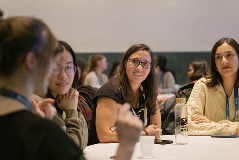Spin-triplet superconductivity discovered in uranium ditelluride
Nov 21, 2019|Season 1, Episode 23
Sophia Chen of MRS Bulletin interviews Nicholas Butch of the National Institute of Standards and Technology about the evidence of topological states found in UTe2. These could possibly function as topological qubits, a favorable “hardware” for quantum computers that should not require error correction. Read the article in Science.
SOPHIA CHEN: Recently, you may have heard that Google’s quantum computer executed an algorithm a billion times faster than a conventional computer. But their machine is far from being broadly useful. No existing quantum computer is. One of the biggest challenges that the technology faces is that the computer hardware—its so-called qubits—interacts with the environment in unwanted ways. This results in computing errors, and no one knows how to correct these errors yet. That’s why researchers are investigating new materials for building qubits that might avoid these errors altogether. Nicholas Butch, a physicist at the National Institute of Standards and Technology, researches a class of materials that can be manipulated into something known as a topological state. A topological state occurs when the material’s electrons are collectively manipulated to behave in a specific correlated way.
NICHOLAS BUTCH: Topological states are in principle robust, or at least more strongly defendant, against that kind of coupling to the noise in the environment.
SC: Materials that harbor these quantum states could then be built into topological qubits, which shouldn’t need error correction. So you could build a comparably powerful computer with much fewer qubits compared to devices like Google’s quantum computer. The company Microsoft is pursuing a quantum computer made of topological qubits. However, it’s been difficult to create these quantum states. So far, researchers have only found indirect evidence of topological states in materials. Recently, Butch and his colleagues synthesized another promising candidate, UTe2, which looks like a silvery crystal.
NB: These are basically the size of typical, let’s say, table salt grains.
SC: While the researchers haven’t directly confirmed that UTe2 is a topological material, they’ve observed properties in it that are associated with topological states. The researchers ran a current through the crystal and found its resistivity went to zero as they cooled it to 1.6 Kelvin.
NB: Even though we know about thousands of superconductors, there’s a very short list of spin triplet superconductors that we know about.
SC: They still have to confirm this, but they suspect it’s this rare type because its properties differ from those of typical superconductors. The heat capacity of typical superconductors usually goes to zero as the material becomes superconducting, but this material’s heat capacity does not. In addition, most superconductors lose their superconductivity if you put them in a magnetic field of around 1 Tesla. In this material, it took 35 Tesla. These properties hint that the electrons in UTe2 pair up in different configurations than they do in a typical superconductor. Theory suggests that if a material shows this distinctive electron pairing, it should also harbor topological states. Butch and his team plan to study how the material responds under increasingly high pressure. They also want to definitively find the topological states. They’ve also found that once you suppress the material’s superconductivity in a 35 Tesla magnetic field, that if you turn the field even higher, the superconductivity comes back between 40 and 60 Tesla. They don’t know why.
NB: We’re in the midst of trying to determine exactly how weird it is.

